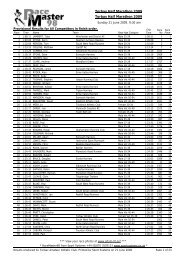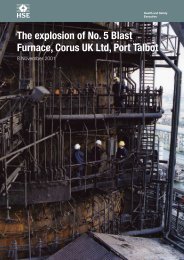A cArbon cApture And storAge network for yorkshire And humber
A cArbon cApture And storAge network for yorkshire And humber
A cArbon cApture And storAge network for yorkshire And humber
Create successful ePaper yourself
Turn your PDF publications into a flip-book with our unique Google optimized e-Paper software.
• ETS auctioned revenues from 2012 are<br />
used to enable 3, 450MW scale IGCC<br />
demonstration CCS plants and associated<br />
infrastructure in the area operational<br />
by 2020.<br />
• The competing uses <strong>for</strong> generation<br />
investment of nuclear, CCGTs and wind<br />
are not compellingly more attractive in<br />
company portfolios.<br />
• The Yorkshire and Humber area has a<br />
low cost base <strong>for</strong> transport and storage<br />
of CO2 from capture sources.<br />
To maintain a steady growth in CO2<br />
reductions beyond the initial government<br />
encouraged demonstrations and maintaining<br />
the above international market drivers<br />
through the 2020s will be moderated<br />
by factors such as<br />
• Good progress in significantly reducing<br />
the technical risks around capture,<br />
transport and storage. This includes<br />
secure storage, acceptable transport<br />
parameters, and operating up times and<br />
costs <strong>for</strong> the capture technologies.<br />
• Reasonable ability of industry to man<br />
up as nuclear builds match about<br />
present fleet. Sufficient knowledge and<br />
skill development to rank the UK as<br />
an important CCS country. This does<br />
assumes a redirection of ef<strong>for</strong>t from<br />
Olympic Games type work to power coal<br />
and nuclear power station construction<br />
from 2011 on.<br />
• There is a definite shift away from oil<br />
<strong>for</strong> transport points to additional power<br />
generation <strong>for</strong> electric/fuel cell cars, but<br />
biofuels and improved efficiency are<br />
helping meet targets.<br />
• Predictable growth in the local <strong>network</strong><br />
size to maintain good utilisation of pipes<br />
and storage to maintain the Yorkshire<br />
and Humber area as a low cost base <strong>for</strong><br />
transport and storage.<br />
• Good public understanding of the CCS<br />
principles and support <strong>for</strong> the concept.<br />
The long term investment decisions towards<br />
the end of the 2020s will have sufficient<br />
confidence in the following issues:<br />
• The long term energy sources <strong>for</strong> the UK,<br />
including long HVDC links, H2 corridors,<br />
energy <strong>for</strong> transport, and the potential <strong>for</strong><br />
fusion, are understood enough to maintain<br />
changing the existing coal emitters to CCS.<br />
Carbon Capture and Storage Network 31<br />
• However efficient use of coal is becoming<br />
an issue but natural gas CO2 capture is<br />
becoming viable.<br />
• Smaller, varied emitters, such as biomass<br />
CHP plants, and industrial processes have<br />
access to capture technology, and can<br />
benefit from CO2 trading and incentive<br />
schemes, to enable them to capture<br />
CO2 and inject into the low cost<br />
regional infrastructure.<br />
8.3 LOW GROWTH SCENARIO<br />
This describes CO2 flow beginning in 2017,<br />
with 8 of 15 Tier 0 sources transporting by<br />
2030. This illustrates a scale of activity <strong>for</strong><br />
an extensive <strong>network</strong>. It is not a low level of<br />
CCS activity- in the worse case nothing may<br />
be built be<strong>for</strong>e the mid 2020s and there is<br />
there<strong>for</strong>e no need <strong>for</strong> a <strong>network</strong> solution. It<br />
achieves some useful impact by 2030.<br />
8.3.1 Scenario concept<br />
Principle influences are assumed to drive<br />
initial investment because of:<br />
• Phase 3 and 4 of the ETS look as though<br />
CO2 values are in the €15-25/tonne range<br />
because of pressure to relax the National<br />
Allocations because of trade fears and<br />
energy intensive industry lobbying and low<br />
cost post Kyoto CDM type certificates.<br />
• The outlook <strong>for</strong> coal prices is <strong>for</strong> 10 to 15<br />
years to remain cheaper than gas but with<br />
increased volatility.<br />
• EU policies covering CCS are not<br />
mandatory and energy security as the<br />
priority is reflected in UK legislation both<br />
in implementing EU policy to reduce<br />
greenhouse gases and in implementing<br />
the UK Climate Change Act target.<br />
No allowances <strong>for</strong> testing storage integrity<br />
or changes to present planning rules <strong>for</strong><br />
CO2 pipelines.<br />
• ETS auctioned revenues from 2012 may<br />
be used <strong>for</strong> demonstration CCS plants<br />
and associated infrastructure by bidding<br />
in “rounds” of capacity.<br />
• The competing uses <strong>for</strong> generation<br />
investment of nuclear, CCGTs and wind<br />
are more attractive, though companies<br />
want CCS in their portfolios.<br />
• The Yorkshire and Humber area may have<br />
a low cost base <strong>for</strong> transport and storage<br />
of CO2 from capture sources.<br />
To maintain any growth in CO2 reductions<br />
beyond the initial government encouraged<br />
demonstrations and maintaining the above<br />
international market drivers through the<br />
2020s will be moderated by factors such as:<br />
• Progress is made in reducing the<br />
technical risks around capture, transport<br />
and storage by pilot plants. This includes<br />
secure storage, acceptable transport<br />
parameters, but there remains uncertainty<br />
over operating up times and costs <strong>for</strong> the<br />
full scale capture technologies.<br />
• There is a focus on nuclear builds and<br />
internationally the UK is not seen as a<br />
knowledge or skill centre <strong>for</strong> CCS.<br />
• Policy, efficiency and oil price moderation<br />
means there is no additional demand <strong>for</strong><br />
electricity, or hydrogen, <strong>for</strong> transport use.<br />
• Growth in the local <strong>network</strong> size is entirely<br />
driven by specific projects and there is<br />
little <strong>network</strong>ing benefit or capacity to <strong>for</strong><br />
new CCS projects to use.<br />
• Public uncertainty of the CCS principles<br />
and support <strong>for</strong> the concept.<br />
The long-term investment decisions towards<br />
the end of the 2020s will have sufficient<br />
confidence in the following issues:<br />
• The long term energy sources <strong>for</strong> the UK,<br />
including long HVDC links, H2 corridors,<br />
energy <strong>for</strong> transport, and the potential<br />
<strong>for</strong> fusion, are understood enough to<br />
discourage investment in coal CCS.<br />
• Natural gas CO2 capture remains unviable.<br />
• Some smaller, varied emitters, such<br />
as biomass CHP plants and industrial<br />
processes have access to capture<br />
technology and benefits from ETS and<br />
incentive schemes to enable them to<br />
capture CO2, but transport and storage<br />
costs are high.

















